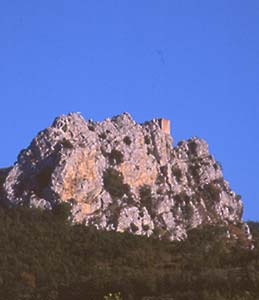 Norman
architecture
Norman
architecture
Remains
dating back to the Norman period can still be found in Molise, even though
they often suffered alterations in subsequent periods. The location of
buildings appears to be one of the main clues to the origin of fortifications.
Distinctions based on the differences in the materials used in different
periods or areas are not possible, since the most commonly used material was
locally quarried stone. Construction and stonemasonry techniques depended on
the level of evolution and wealth achieved by the urban settlements. Moreover,
the numerous reconstructions and functional adaptations of fortified buildings,
which were rendered necessary, to a certain extent, by the high seismicity of
the region, complicate the investigation efforts even further.
The Normans, who in the Chronicon are described as great builders of
castles, certainly found a land that was already characterised by fortified
buildings dominating the burghs, with occasional isolated defensive elements.
The Normans, over a period of a century and a half, seized power from the
Longobards, creating a network of castles more suitable to their fighting
requirements and new defensive strategies. The capillary Norman penetration
led to the creation of a sufficiently homogenous network of military
structures. The function of the castles gradually changed from the
military-political one of the Longobard princedoms and Byzantine temi
to the military-feudal one of Norman domination. The autonomous nature of the
Longobard fortifications was rendered obsolete by Norman architecture, which
satisfied more comprehensive defensive requirements and spread an increasingly
tighter net on the territory.
The Normans did not confine their efforts to the simple re-adaptation of
pre-existing Longobard strongholds. They build new structures, adopting models
that, though initially imported, were gradually modified to suit the peculiar
morphological conditions of the Molisian territory. Those which occupied the
best positions eventually become the pole of attraction for others who, after
a while, reunited, thus laying the foundations for the development of the
second stage of feudalism.
The survival in inland and mountainous areas of land administration structures
and processes which dated back to the Roman period, even after the decline of
the latter, prevented the development of a system which allowed the castle to
function as the effective administrative and institutional core. It is quite
probable that the concepts of motte and donjon had to be
modified in those Molisian areas that are prevalently mountainous (their
presence is in any case substantiated by the survival of the toponyms), and
adapted to environmental conditions different from those previously
experienced by the Normans. On the other hand, in the flat areas of Apulia and
Calabria the traditional models, similar to those in France, were followed
more closely. During the early stages, fortifications that were originally
made of wood (or mainly wood) were transformed into stone structures. Later,
new buildings were constructed entirely of stone.
The castle building phenomenon in Molise was motivated by the political and
administrative instability of the times, while the development of the feudal
society was strongly affected by the presence of the abbey of St. Vincent. In
the Volturno river valley the settlement phenomenon was preceded by a phase of
centralisation, consequent on the reclamation of the “silva densissima”
accomplished by the peasants organised by the monks. Under the pressures of
the Longobard counts, of the Saracens and of the Normans themselves, the
military defences were reorganised: burghs enclosed by walls were established,
such as Forneli, Scapoli and Santa Maria Oliveto (“castrum costituit in
montem” after 1066). The castella represented the concluding
stage in the process of exploitation of the territory, and were the
foundations for the subsequent expansion of the settled areas and for
sustained building activities.
 Il comune informa
Il comune informa 

